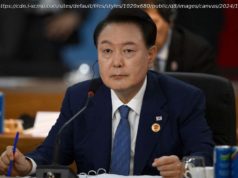The U. S. claims Trump pressed Russia on interference in the election, while Russia claims the U. S. accepted that the Kremlin is innocent. Who knows what to believe?
Updated July 7 at 4 p.m.
Pundits eager to analyze the outcome of Friday’s first face-to-face meeting between U. S. President Donald Trump and Russian President Vladimir Putin don’ t have much to go on. (Bold prediction: That won’ t slow them down.)
In the absence of material information, many analysts rushed to read meaning into the length of the meeting in Hamburg, which was scheduled for just 30 minutes but dragged on for more than two hours. Attendance at the meeting was sharply limited, reportedly in order to avoid leaks: There were just six people in the room, including each president’s foreign-policy chief and an interpreter for each side. That means that anyone curious to know what was discussed is forced to rely on the accounts of the two governments involved—neither of which has a sterling reputation for honesty.
The Strange, High-Pressure Work of Presidential Interpreters
Adding to the confusion, the two initial accounts of the meeting differ sharply. Russian and American officials, together with Jordan, announced a cease-fire in southwest Syria, the one major material accomplishment, though one that based on Jordan’s involvement was clearly in the works long before the two presidents met. The two sides also agreed to set up a working group on cybersecurity. From there, accounts diverge, creating a Rashomon -like situation in which it’s likely impossible to piece together what actually happened.
Rex Tillerson, the U. S. secretary of state, briefed reporters in Hamburg on the discussion. Tillerson said Trump had begun the meeting by pressing Putin about Russian interference in the 2016 presidential election.
“The president opened the meeting by raising the concerns of the American people regarding Russian interference in 2016 election. Putin denied such involvement, as he has done in the past, ” Tillerson said. He said that Trump had returned to the topic more than once during the meeting. (As the meeting ran over, first lady Melania Trump was reportedly sent inside in an unsuccessful attempt to get the men to wrap up.)
Russian Foreign Minister Sergei Lavrov, also briefing reporters in Hamburg, agreed that Trump had brought up the accusations, but that Trump had accepted Putin’s version of the events, which is that Russia is innocent of any involvement. U. S. officials denied that. He also claimed Trump had dismissed the allegations: “Trump mentioned that in U. S. certain circles still inflate subject of Russian meddling in elections, even though they have no proof.”
It’s hard to know what to believe. Lavrov and Russia have obvious motivation to lie about what happened. But Trump has repeatedly shown that despite his bluster about being a tough negotiator, he can be easily persuaded by foreign leaders during face-to-face meetings, abandoning long-held positions when effectively debated by a counterpart. (This is one reason that Putin, like other foreign leaders, was so eager to meet in person.)
Moreover, Trump’s own view on the interference in the election remains opaque. He has never fully accepted the judgment of U. S. intelligence agencies and most of his own aides that Russia was behind hacking of email accounts and other feints. Most recently, on Thursday in Warsaw, Trump suggested that Russia might have been involved but might not have been alone, and concluded, “Nobody really knows. Nobody really knows for sure.”
Since Tillerson has been faster to accept Russian interference, he of course has his own motivation for establishing a narrative that Trump also accepts it. But Tillerson also signaled that the U. S. was focused on “how to we move forward from here, because it’s not clear to me that we will ever come to some agreed-upon resolution.” While well short of accepting Russia’s account, that does veer toward agreeing to disagree and move on, which would also be a victory for the Kremlin. But in the context of this unresolved disagreement, the establishment of a cybersecurity working group with the two countries is somewhere between a head-scratcher and a punchline.
Lavrov chose to deliver his remarks to reporters on camera; Tillerson, in contrast, insisted on an off-camera briefing, though audio recordings were allowed. Tillerson has repeatedly shied away from media. On a trip to Asia, he blocked the standard press pool, traveling instead with only a single American reporter, from a friendly conservative outlet. But the decision backfired on Tillerson, as confusion and erroneous reports from local press came to shape the trip, and there were no U. S. reporters around to correct them.
Situations like this are why foreign leaders typically agree to readouts or even joint statements after meetings. That means that whatever differences occurred in the meeting, each side can reliably know what the other side will say publicly. Several times in the Trump administration, other countries have released far more detailed readouts of discussions than the U. S., laying bare more than the White House intended. In this case, the Trump administration, thanks to multiple incidents of self-contradictory messaging and outright untruths, can’ t rely on the benefit of the doubt.
Ahead of the meeting, many analysts worried that Putin would use the meeting to somehow humiliate Trump and the United States, and in the absence of a readout, this particular trick by Russia seems almost inevitable in retrospect. If there is a consolation for Trump, it’s that he is not the first president to fall into one of Putin’s traps. George W. Bush declared that he had looked into Putin’s eyes and seen a good man; Barack Obama embarked on a quixotic “reset, ” only to see Russia invade Ukraine and meddle in the election. As for Trump, he has been heralded and harangued as a post-truth president. Now, with no single reliable version of what happened between Trump and Putin, there’s effectively no truth about it at all.






